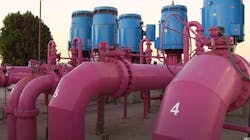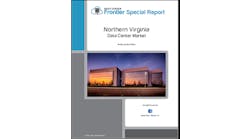Amazon Web Services, the world's largest cloud computing platform, intends to be water-positive by 2030, returning more water to communities than it uses in its direct operations. The announcement highlights how water scarcity is now a priority for data center operators, as AWS joins the other large hyperscale platforms - Microsoft, Google, Meta and Apple - in outlining water strategies.
As part of the "water+" initiative, Amazon Web Services shared the Water Usage Effectiveness (WUE) for its data centers, and said it will report annually on its WUE, new water reuse and recycling efforts, as well as new activities to reduce water consumption in its facilities.
“Water scarcity is a major issue around the world and with today’s water positive announcement we are committing to do our part to help solve this rapidly growing challenge,” said Adam Selipsky, CEO of AWS. “In just a few years half of the world’s population is projected to live in water-stressed areas, so to ensure all people have access to water, we all need to innovate new ways to help conserve and reuse this precious resource."
Extreme heat and drought are bringing sharper scrutiny of data center water use, raising the bar for fast-growing cloud computing platforms and data center developers. These companies are facing growing scrutiny about their data center water use as they announce new projects in regions facing severe drought such as Phoenix.
The AWS announcement was among a flurry of news items on the first day of the annual AWS re:Invent conference in Las Vegas. Many of the new water initiatives focus on replenishing local water supplies and offset the water impact of AWS' cloud business on communities that host its data centers.
But the company also disclosed some details of how water is used in its data center operations, and highlighted several programs that
"We're working within our data centers to implement innovative solutions that help us improve water efficiency and reduce our water use." said Will Hughes, Water Sustainability Lead for AWS.
How AWS Cools Its Data Centers
Amazon typically uses two modes of cooling in its data centers, according to Suresh Soundararaj, AWS Principal Mechanical Engineer.
- When the weather is cool, AWS uses direct air cooling, introducing fresh air into the data center to cool servers.
- When the temperature is warmer, AWS uses an evaporative cooling system in which fresh air is forced through water-soaked cooling pads, The water evaporates, reducing the air's temperature, and the cooler air is introduced into the data halls to cool equipment.
AWS uses sensors to detect changes in temperature that allow it to shift between modes, according to Soundararaj. That approach has provided AWS with WUE of 0.25, meaning it uses 0.25 liters of water per kilowatt-hour. That's lower than the industry average of 1.7, but about equivalent with Meta, which has reported a WUE of 0.26.
Water usage can vary along with the regional climate. In Ireland and Sweden, AWS uses no water to cool its data centers for 95% of the year. Microsoft reports similar success, with a WUE of 0.01 for its facilities in Europe, but higher figures in warmer climates in North America (0.55) and Asia Pacific (0.99). It will be interesting to see if future AWS reporting breaks out its WUE by region, as Microsoft has.
AWS also invests in on-site water-treatment systems that allow it to reuse water multiple times, minimizing water consumed for cooling. After maximizing the use of water in its data centers, the spent liquid is still safe for some other uses. In Umatilla, Oregon, AWS provides up to 96% of the cooling water from its data centers to local farmers at no charge for use in irrigating crops like corn, soybeans, and wheat.
AWS also highlighted its use of recycled water, which preserves valuable drinking water for communities, but is only available where local utilities have created systems offering recycled water to customers. AWS said it uses recycled water for cooling in 20 data centers around the world, including facilities in Santa Clara County in California and Loudoun County in Virginia. The company said it has plans to expand recycled water use in more facilities as it works toward becoming water+.
“The progress AWS has made in using recycled water for cooling in 20 of their data centers already shows great leadership for the industry," said Patricia Sinicropi, executive director of WateReuse Association. "We look forward to collaborating with Amazon to implement water reuse for the benefit of their operations and for the communities in which they operate.”
The AWS press release noted that "AWS worked with Loudoun Water to become the first data center operator in the state approved to use recycled water in direct evaporative cooling systems." While a meaningful milestone for a specific cooling approach, it should be noted that the Loudoun Water recycled loop has been available since at least 2013 and is used by many data center facilities in Ashburn.
Selipsky: More Water Innovation to Come
Amazon also didn't share any information about whether it plans to raise the operating temperature in its data halls to save water, a step that has been taken by Meta and Microsoft.
There's much more to come on the water optimization front, according to Selipsky.
"While we are proud of the progress we have made, we know there is more we can do," he said. "We are committed to leading on water stewardship in our cloud operations, and returning more water than we use in the communities where we operate. We know this is the right thing to do for the environment and our customers.”
AWS is investing in water replenishment projects in the communities where it operates. Replenishment projects expand water access, availability, and quality by restoring watersheds and bringing clean water, sanitation, and hygiene services to water-stressed communities.
In California, AWS is working with the conservation non-profit Freshwater Trust, and the Omochumne-Hartnell Water District to recharge 189 million liters of groundwater per year using winter water from the Cosumnes River. This will allow water to gradually flow through the groundwater table and back into the Sacramento and San Joaquin watershed, increasing water flows during drier summer months. This lowers the temperature of the river, improves salmon habitat, and increases summer flows into the San Francisco Bay Delta, a critical water supply source for the communities in the region.
ADDITIONAL RESOURCES: More information on AWS Water+ can also be found on at Amazon’s Water Stewardship in Data Centers web site, an accompanying blog post and in its press release, which includes details of the company's work with partners on water replenishment. Here's a video from the AWS team on its water efforts. .








